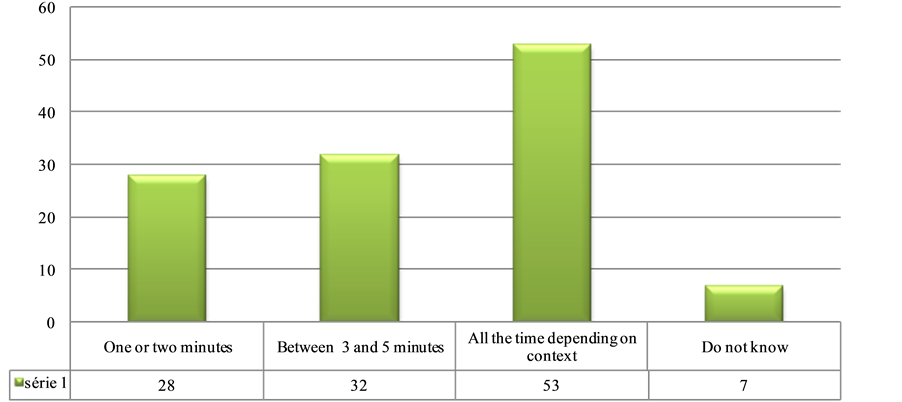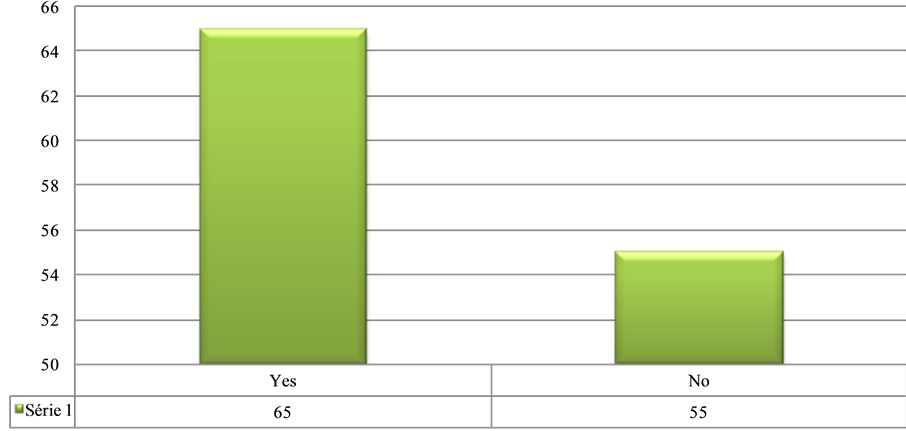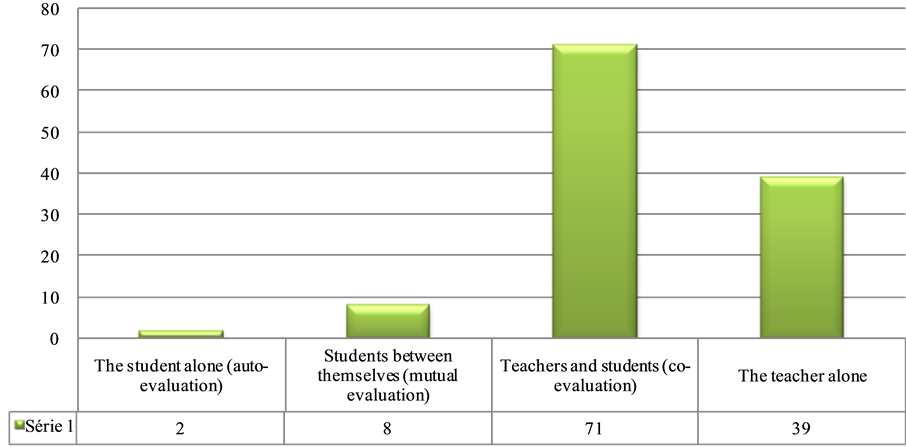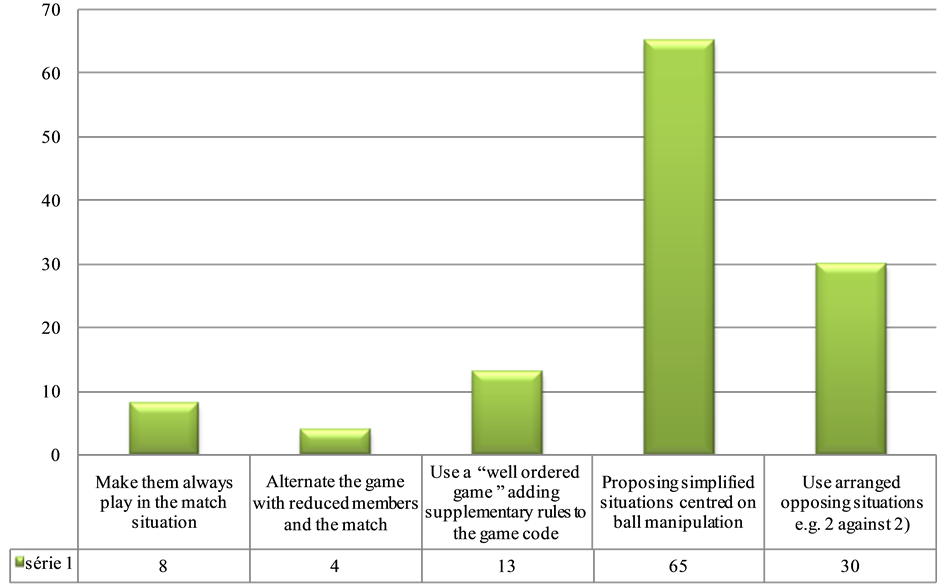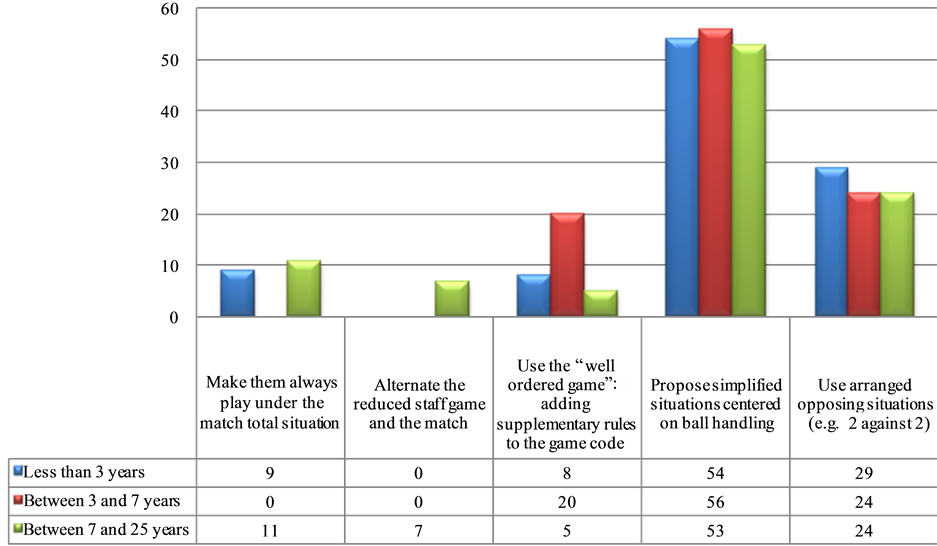Creative Education
Vol.06 No.14(2015), Article ID:58883,6 pages
10.4236/ce.2015.614161
Verbalization in Sport and Physical Education Study of Volleyball Teachers’ Conceptions
Najmeddine Ouesslati, Rim Mekni, Hajer Sahli, Anissa Bouassida
High Institute of Sports and Physical Education, Kef, Tunisia
Email: makwiss@yahoo.fr
Copyright © 2015 by authors and Scientific Research Publishing Inc.
This work is licensed under the Creative Commons Attribution International License (CC BY).
http://creativecommons.org/licenses/by/4.0/



Received 5 June 2015; accepted 15 August 2015; published 19 August 2015
ABSTRACT
In nowadays SPE lessons, many teachers and their colleagues talk about other disciplines. This is certainly due not only to the evolution of our disciplines last two decades or to the institutional requirements they entail, but also to the teacher’s own personality and to the conception that elaborates his/her work (Thierry, 2007) . This article aims to clarify volleyball teachers’ regards towards teaching/learning process that is based on verbalization. First, we compared the answers of teachers who were interrogated regardless of different variables, using the “global analysis method”. Then, we used the “differential” method to notice the impact of the variables “teaching experience” and “grade” on teachers’ conceptions. Verbal intervention is necessary in exercising the teaching profession. One can say that this verbal intervention can be both a constraint and a resource, but it constitutes certainly one of the charisma bases and teacher’s authority. Certain studies (Galacteros and Lavorel) showed that verbalization, in all its aspects (phonation, gesture, words arrangement, and discourse structure) could reveal the construction of the speaker personality. A transposition of this close dependence is found in a sentence of J.-C. Fortin (School and Culture): “no one can really teach if he does not teach something true or valid in his own eyes”.
Keywords:
Verbal Intervention, Learning, Conception, Volley Ball

1. Introduction
Verbal interactions between teachers and students make the goal of multiple studies carrying on their pedagogical aspects (Altet, 1994) and didactics ( Amade-Escot, Barrué, Bos, Dufor, Dugrand, & Terrisse, 1998 ; Marsenach, 1987; Sarrazy, 2001). Before tackling the specific of scholar verbalization in SPE, a little detachment is necessary to emphasize (as it was required) cultural occurrence and words simultaneity. Speech remains commutative: whether it is laying down paper or simple vibrations in the air, it is generally interpreted, from one language to another. Therefore, we can say that even if the cultural contain changes, the content or the message remains universal. A speech without a brain, larynx, and lung is inconceivable, “may be even if there is no act more fully human” (Boris Cyrulnik, Monkey Memory and man speeches). According to Merleau-Ponty, “in a child’s mind, if the other does not exist the speech does not constitute”.
In fact, verbalization represents a crucial educational element in SPE teachers’ interventions (Austin, 1970) . Its set is like that which should be considered a real teaching content requiring anticipation, planning, and efforts of balance and distribution, in our sessions’ preparation. It is a major professional asset. Its nature and strength are from our teaching discipline specifics compared to other intervening sectors in physical and sportive activities. Speech contributes to strengthening the identity of scholar physical education, which we are constantly seeking for. Thereafter, it participates in largely establishing its legitimacy within the school and the educational system.
This study aims at recognizing SPE teachers’ conceptions in what concerns volleyball teaching. Indeed, we have endeavored to gather information about particular situations taking into consideration teachers’ professional task, their agreement as well as variation in their conceptions when intervening with students who are voluntarily engaged in this structure (Oueslati, 2014) . Furthermore, we attempt to renew the methods they follow in conceiving volley ball teaching. How do teachers observe their tasks? What are their views towards their actions?
2. Methodology
We implemented, first, the “global” analysis method to compare answers of the interrogated teachers. Then, we applied the “analytical” method to notice the influence of the variables “educational experience” and “grade” upon teachers’ answers. This study engaged 120 volleyball teachers in school establishments in EL Kef city.
The differential analysis aims at seeing whether there is an important influence of free variables on teachers’ answers or not.
According to Michèle Masson (1994) the questionnaire selection is attributable to its efficiency on communal and direct collection of teachers’ conceptions. We selected questions that afford the most possible signs (a more valid and reliable communication and treatment). The questionnaire allowed us to organize statistical analysis task and to set up the features of the intended sample.
The questionnaire contains 5 major items:
First Item: Importance of the technique teaching with verbalization.
Second Item: Importance of verbal exchanges in-between students in class.
Third Item: Importance of language interactions between teachers and students.
Fourth Item: Students’ Assessment Process.
Fifth Item: Teachers’ conceptions concerning Volleyball teaching.
Previous to managing the questionnaire and our study sample we were consulted to control comprehension and constancy of our determining levels. For the comprehension, we used obvious and comprehensible technical words. Moreover, our sample consists of entirely sports and physical education teachers and we cooperate with specialists to perform the choice of different questions (in Physical and Sportive Activity teaching and scholar Volleyballs), we also depend on prior researches in PSA didactics. We used the global khi2 test in order to analyze teachers’ conceptions and the analytical khi2 to detect the effect of different independent variables on teachers’ answers.
3. Results
This study engaged 120 volleyball teachers in school establishments in EL Kef city, as shown in the Table 1.
Table 1. Demographic characteristics of volleyball teachers.
3.1. Global Analysis
The overall study of scholar volley ball teachers’ conceptions showed that the majority of them (teachers) do not assert that accuracy, relevance and verbal interaction nature directly affect the student practice nor can partly intervene in his success or failure
First Item: Importance of the technique teaching with verbalization.
Finding
44% of interviewed teachers in Figure 1 said that the time for verbal interaction in between students during a volley ball session depends on educational context, while 23% consider that one o two minutes are satisfactory for students to verbalize, and only 27% of them are attributed to the good answer justified by experts, according to Jean-Francis Gréhaigne (1998) the discussion time given to students during a volley ball session must be limited to 3 and 5 minutes.
Second Item: Importance of verbal exchanges in-between student in class.
Finding
73% of interviewed teachers in Figure 2 assert that students’ performance can be improved through student-
Figure 1. Frequencies of answers relating to the fifth question, ‘how long you allow your students to discuss during the session?”
Figure 2. Frequencies of answers relating to the 4th question “do you think that discussion with students can improve their own performance?”
teacher interaction while other teachers do not believe that discussion with students can influence their own performances.
Third Item: Importance of language interactions between teacher-students.
Finding
65 teachers in Figure 3 have valued the importance of verbal intervention during a volley ball session; they consider that teacher’s speech can replace a gestural demonstration, while 55 teachers see that gestures demonstration cannot be replaced by teachers’ speech.
Fourth Item: Students’ Assessment Process.
Finding
Just two teachers in Figure 4 report that only the student can assist in the assessment task (self-assessment), while 39 teachers see that only teachers must evaluate in volley ball, and the majority affirm that assessment task must be performed by both; teacher and students (co-assessment).
Figure 3. Frequencies of answers relating to the second question “according to you, does your speech can replace a gestural demonstration?”
Figure 4. Frequencies of answers relating to the 17th question “who do you think should evaluate in volley ball?”
Fifth Item: Teachers’ conceptions concerning volleyball teaching.
Finding
To make students learn in volley ball, interviewed teachers in Figure 5 see that it is first necessary to propose simplified situations centered on ball manipulation (54%), then to use arranged opposing situations (e.g. 2 against 2) (25%), to use “well ordered game” adding supplementary rules to its code (11%), make them play all the time under the game total situation (7%), and finally alternate the game with reduced members as well as the match.
3.2. Differential Analysis
Tunisian teachers’ conceptions were clearly affected by the “educational context” variable shown through the differential analysis. Indeed, university teachers (in ISSEP EL kef) mostly prefer to depend on this approach “teaching with verbalization”, while their colleagues in other different establishments remain skeptical.
a) Educational context variable
In Figure 6 most teachers at school (34%), college (67%), high school (47%), and university (30%) report that their interventions during a Volleyball session to “demonstrate correct gestures”, and those who choose to “give verbal instructions” are minority (13%) at school, none in college, (18%) in high school and (33%) at university. While (48%) of school teachers, (33%) in college, (12%) in high school and (37%) at university prefer to combine the two methods together.
b) Seniority variable
Finding
In Figure 7 during a volleyball session 54% of trainee teachers, 56% with work experience between 3 and 5 years, 53% aged between 7 and 25 years old prefer proposing simplified situations centered on ball handling, 29% of trainee teachers and 24% who have between 3, 5, 7 and 25 years of seniority choose arranged opposing situations (e.g. 2 against 2. While only 9% of trainee teachers and 11% of experienced teachers opt always for making students play under the game total situation, and 20% of teachers between 3 and 7 years of seniority prefer to use the “well ordered game” adding supplementary rules to the game code.
Figure 5. Frequencies of answers relating to the 11th question in your opinion, what must be done to make students learn in volley ball.
Figure 6. Frequencies of answers relating to the first question “during a volley ball session, what do you prefer?”.
Figure 7. Frequencies of answers relating to the 12th question; “what do you think should be done to make students learn in volley ball?”
4. Discussion
Most teachers emphasized on the importance of increasing the motor engagement than soliciting from students a certain reflexive practice in and through the action in volleyball game. In other words, the representations conveyed by these teachers reflect a behaviorist conception that considers the teacher as being the forever responsible for knowledge construction regardless of students’ intervention.
As a matter of fact, these teachers resist when facing a teaching/learning modality in-between students’ discursive interlocutions;
Yet, in recent years, many studies put the accent on the necessity of putting students in situations of knowledge co-elaboration, in and through the action (Oueslati, 2014) .
The goal then is to get students describe the game, identify the different meetings and finally opt for a joint decision. In this perspective, Wallian & Chang, 2007; Zghibi (2009) focused their studies on the importance of adopting learning techniques based on language activity in a continuous way during physical and sportive education sessions (PSE). Roulet (1980) also showed the role of language activity under the socio-constructivist approach (social approach). However, new recent researches have largely focused on this activity but this time under the semi-constructivist approach (semiotic approach) that lies in the extension of socio-constructivist approach.
5. Conclusion
In “behaviorist” conception, teacher’s presence is always paramount. During this conception, knowledge transmission is a passage of information from someone who knows (the teacher) to another who does not know (the student). This relationship gives the major role to the teacher at the expense of the student. Thereafter, this latter cannot discuss and formulate game proposals, whereas teachers can evaluate and propose game situations. Once verbalization does exist, it must be all the time under the teachers’ sole control.
Thierry (2007) asserted that teaching was a profession of speech. The vocal apparatus on the whole has an extreme complexity which we constantly tackle when working in enormous and open conditions; in cold, hot, dry or wet atmosphere, often dusty. The immediate consequence: we must maintain it. The experience is repeating every day with students, when we come up to them without the need to look them in order to identify who is speaking.
Cite this paper
NajmeddineOuesslati,RimMekni,HajerSahli,AnissaBouassida, (2015) Verbalization in Sport and Physical Education Study of Volleyball Teachers’ Conceptions. Creative Education,06,1603-1609. doi: 10.4236/ce.2015.614161
References
- 1. Amade-Escot, C., Barrué, J.-P., Bos, J.-C., Dufor, F., Dugrand, M., & Terrisse, A. (1998). Researches in SPE : Review and Prospects. Paris: Éditions Revue SPE.
- 2. Austin, J. (1970). When to Say, Is Doing. Paris: The Threshold.
- 3. Gréhaigne, J. F., & Godbout, P. (1998). Observation, Critical Thinking and Transformation: Three Key Elements for a Con- structivist Perspective of the Learning Process in Collective Sport. In R. Feingold, & R. Rees (Eds.), Conference’ Acts of the Current Events in Researches in Education and Training (pp. 109-118). Geneva: University of Geneva.
- 4. Oueslati, N. (2014). Reflexive Practice in Volley Ball through the Designs of Sport and Physical Education Teachers. Inter- national Journal of Advanced Scientific and Technical Research, 2.
http://www.rspublication.com/ijst/index.html - 5. Thierry, D. (2007). Speech: Expression of the Person. PES Notebook, No. 36, 59.
- 6. Wallian, N. & Chang, C. W. (2007). Language, Thinking and Action: Towards a Semio-Constructivist Approach in Physical Education. Physical Education and Sport Pedagogy, 12, 289-311.
http://dx.doi.org/10.1080/17408980701610219 - 7. Zghibi, M. (2009). Students’ Linguistic Interactions and Apprenticeship in Football: The Case of Four Classes of 9th Year Basic Education in Tunisia. PhD Thesis in Sciences of Sport, Besançon: University of Franche Comté.



